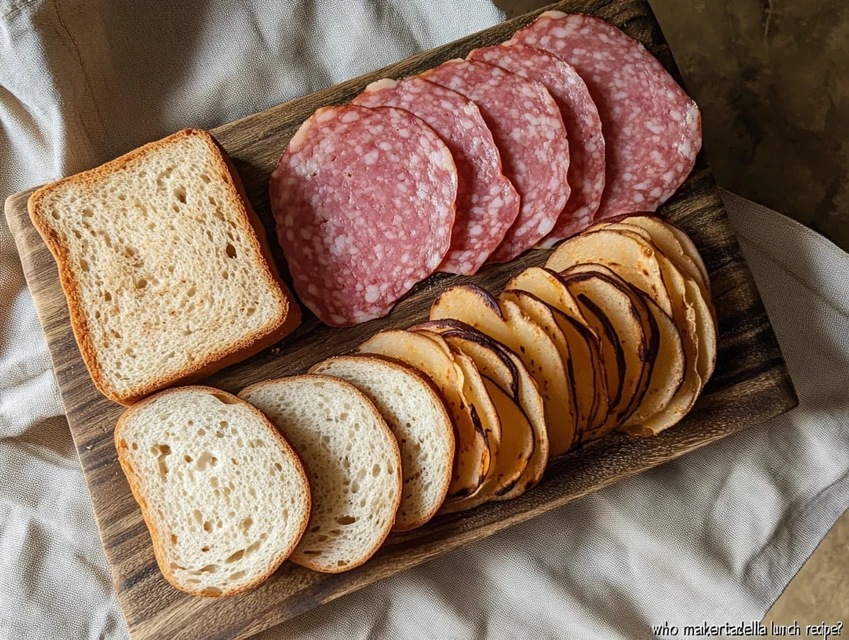Mortadella is no ordinary lunch meat. It stands for Italian tradition, refined flavors, and a culinary story spanning centuries. But who makes mortadella lunch meat recipe? This question arises for many seeking authentic taste and rich heritage. Albeit there are many producers, the art of mortadella-making involves careful craft, high-quality ingredients, and time-honored techniques.
Accordingly, the question of who makes mortadella lunch meat recipe? resonates strongly with many food enthusiasts. In the U.S., a surge of interest has encouraged producers, restaurants, and home cooks to appreciate this distinctive deli meat. Formerly, mortadella may have seemed rare. Yet, nowadays, you can find several commercial and artisanal offerings at specialty stores. Certainly, this shift reveals a growing respect for authentic flavors and quality ingredients.
Before we move on, it’s vital to recognize that knowing who makes mortadella influences the quality and taste you experience. Basically, understanding its producers, both in Italy and America, helps you select the best slices for your plate.
Understanding Mortadella
Who makes mortadella lunch meat recipe? Before tackling that more, we must define mortadella. Mortadella is a large Italian sausage, produced chiefly from finely ground pork mixed with spices and notable fat cubes. Initially, some might confuse mortadella with bologna, but there are distinct differences. Comparatively, mortadella is creamier, richer, and more aromatic than standard bologna. Certainly, its flavors are altogether more nuanced.
In Italy, it is often sliced paper-thin. Equally, mortadella’s aroma, taste, and melt-in-your-mouth consistency make it a standout product. Eventually, you learn that its delicate balance of spices, i.e., pepper and myrtle berries, sets it apart. Notably, the fragrant spices and cubes of flavorful fat result in a smooth, buttery texture. Another aspect: mortadella is not just another lunch meat; it is Italy’s gastronomic icon.
Traditionally, Italian mortadella contains high-quality pork shoulder. Afterwards, the meat is finely ground, seasoned, and cooked gently. Indeed, this process yields a delicate texture. Because real mortadella from Bologna has PGI status, it must follow strict guidelines. Hence, authenticity matters.
Nutritionally, mortadella is rich in protein and fats. Although not a lean meat, it offers a moderate protein boost. Markedly, enjoying mortadella in moderation ensures you appreciate flavor without overindulging. Undoubtedly, its nutritional profile mirrors that of other cured meats: flavorful, but to be enjoyed with balanced portion sizes.
Traditional Producers of Mortadella in Italy

Who makes mortadella lunch meat recipe best? Historically, small Italian artisans in Bologna hold that honor. In that region, mortadella production is art. Equally, these butchers follow age-old recipes passed down through generations. Comparatively, large factories cannot match the intimacy of these artisans, who select top pork cuts, spices, and natural casings.
Italian brands like Negroni, Beretta, and Felsineo are well-known for top-tier mortadella. Correspondingly, these brands respect strict guidelines and quality parameters. Additionally, the Italian consortia ensure producers use authentic ingredients. Henceforth, these organizations prevent lower-quality imitations. Consequently, consumers trust these labels to deliver genuine mortadella.
Modern Commercial Producers and the U.S. Market
In the United States, mortadella was once hard to find. However, migration brought Italian culinary traditions across the Atlantic. Gradually, certain American producers began making their own versions. Comparatively, these are adapted to local tastes and regulations. Nevertheless, top-quality imports remain widely sought.
You can find mortadella in gourmet delis, specialty stores, and some supermarkets. Moreover, Italian-American communities encouraged local producers to replicate authentic methods. Altogether, these efforts ensured a steady supply of mortadella. Now, who makes mortadella lunch meat recipe in the U.S.? Certain small-scale charcuterie makers and reputable brands produce mortadella styled after the Italian original.
Additionally, mass-market brands offer mortadella-like luncheon meats. Evidently, quality may vary. Therefore, knowing the producer is vital. Because producers differ, you must read labels and ask your butcher about origins. Identically, this approach ensures you get the authentic taste you desire.
Why It Matters Who Makes Mortadella Lunch Meat Recipe?
Surely, the producer’s identity directly affects flavor, texture, and authenticity. Artisanal makers often use higher-quality pork and traditional curing methods. By contrast, large-scale manufacturers may rely on additives or cheaper cuts. Certainly, the difference shows in taste. By understanding who makes mortadella lunch meat recipe?, you gain insights into flavor nuances and health considerations. Obviously, a cleaner product with fewer additives can be a better choice.
Culturally, mortadella symbolizes Italian heritage. Hence, buying from authentic sources supports tradition. Also, choosing artisanal producers often means supporting sustainable and humane farming practices. Overall, this understanding leads to a more satisfying culinary experience.
Making Mortadella at Home: A Step-by-Step Recipe
Many wonder if they can craft mortadella from scratch. Although challenging, it’s possible. If you ask who makes mortadella lunch meat recipe?, the surprising answer: you can. Certainly, homemade mortadella allows complete control over flavors. Because you select ingredients, you determine quality. Before starting, gather proper equipment: a meat grinder, sausage stuffer, and casings. Further, choose top-quality pork shoulder and fresh spices.
Moving to the next part, here are the main steps:
- Select Ingredients: Choose fresh, well-marbled pork shoulder and quality backfat. Add spices like white pepper, nutmeg, and myrtle berries.
- Grind and Emulsify: Grind the pork finely. Afterwards, emulsify it to achieve a smooth consistency. Keep ingredients cold to ensure a stable emulsion.
- Stuff the Casings: Fill natural or synthetic casings. Tie them securely.
- Poach Gently: Poach the encased mortadella in hot water until internal temperature reaches safe levels.
- Cool and Slice: Chill thoroughly before slicing thin. The result is creamy and aromatic.
Also, maintain consistent temperature to avoid graininess. Adjust seasonings according to taste. If texture seems off, re-check the grinding process. Because practice improves results, try different spice blends to find your perfect balance.
Serving Suggestions and Culinary Uses

Basically, mortadella shines on antipasto platters. Slice it thin and serve with olives, cheeses, and crusty bread. Additionally, add it to sandwiches or panini for a sumptuous treat. Mortadella mousse is another idea, blending whipped cream and finely chopped mortadella. Traditionally, mortadella pairs well with mild cheeses, e.g., fresh mozzarella. Another approach: dice it into pasta sauces or use it as a pizza topping.
For drinks, a light red wine or sparkling prosecco complements mortadella’s richness. Moreover, crisp beers or even dry ciders work well. Comparatively, the combination of smooth sausage and bubbly beverage offers a balanced experience.
Sourcing High-Quality Mortadella in the U.S.
When searching for genuine mortadella, visit specialty markets or Italian delis. Formerly uncommon, these shops now often carry PGI-certified products. Prioritize labels mentioning “Mortadella Bologna PGI.” Identically, online gourmet stores offer imported mortadella. Check reviews to ensure reliability. Also, look at the ingredient list for authenticity. Avoid brands using fillers or artificial flavors.
Storage, Shelf Life, and Food Safety
After purchasing or making mortadella, store it in the fridge. Wrap slices tightly to prevent drying. Previously sliced mortadella lasts a few days. If buying a whole log, keep it in the original packaging. Freezing is possible but changes texture slightly. Thaw slowly in the fridge. Because spoilage risks exist, check for unusual odors or sliminess. Dispose of any suspect slices.
Sustainability, Ethics, and Future Trends
Today, many consumers care about humane farming and sustainable production. Notwithstanding the complexity, some mortadella producers source pork from farms with better animal welfare standards. Also, eco-friendly packaging reduces environmental impact. Eventually, plant-based versions may emerge, aiming to replicate mortadella’s signature flavor with vegan proteins.
Frequently Asked Questions (FAQ)
Does boar’s head make mortadella?
Boar’s Head, a well-known U.S. deli meat brand, does produce its version of mortadella. Although it may not match the exact Italian style, many consumers find it accessible and flavorful. Consequently, Boar’s Head offers an option for those seeking mortadella at mainstream grocery stores.
Why was mortadella banned in the US?
Mortadella itself was not outright banned, but import restrictions previously limited certain Italian meats. Initially, food safety concerns and animal disease outbreaks led the USDA to restrict some imports. Eventually, as standards improved, authentic Italian mortadella returned to U.S. markets. Nowadays, you can find genuine varieties with proper certifications.
What is the white stuff in mortadella lunch meat?
The white cubes visible in mortadella are cubes of solid pork fat. Surprisingly, these fat pieces add flavor, moisture, and signature texture. Basically, without these creamy fat specks, mortadella would lose its rich, buttery mouthfeel.
Why is mortadella so cheap?
Mortadella, while rich in flavor, often costs less than other cured meats. This may seem contradictory. However, large-scale production and availability drive costs down. Also, using standard pork cuts makes it more economical. Nevertheless, artisanal mortadella or imports with PGI status can be pricier, reflecting higher-quality ingredients and careful craftsmanship.
Conclusion
Who makes mortadella lunch meat recipe? We’ve discovered that artisans in Italy, famous brands, smaller American producers, and even home cooks can claim that title. Indeed, understanding who makes it influences flavor, texture, authenticity, and ethical considerations. Because mortadella represents culinary tradition, buying it from reliable producers ensures a top-tier experience.
You might also like:
Delicious Vermont Onion Dip Recipe
Simple Homemade Big Mac Sauce Recipe
Delicious Baked Branzino Recipe

